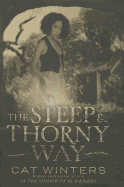 The Steep and Thorny Way chronicles the life of sixteen year old Hanalee Denney, whose parents are an interracial couple in 1920’s Oregon. Hanalee is still mourning the loss of her father nearly two years before, and the story begins with Hanalee confronting the boy who hit her father while driving under the influence. He suggests that her father was killed by Hanalee’s new stepfather, Uncle Clyde, which leads her down a twisted path as she tries to learn what really happened to her father and uncovers many dark secrets along the way. Using the framework of Shakespeare’s Hamlet, Winters explores several issues of the the time including racial divides and the rise of the Ku Klux Klan, homophobia and the eugenics movement, and the pressure to conform to society that fueled them. Although Hamlet is by no means the main focus of this book, it plays a critical role in the way Winters portrays her characters and how they interact. For example, the strained relationship between Hanalee and her Uncle Clyde is a clear reference to Hamlet’s feelings toward his own Uncle Claudius.
The Steep and Thorny Way chronicles the life of sixteen year old Hanalee Denney, whose parents are an interracial couple in 1920’s Oregon. Hanalee is still mourning the loss of her father nearly two years before, and the story begins with Hanalee confronting the boy who hit her father while driving under the influence. He suggests that her father was killed by Hanalee’s new stepfather, Uncle Clyde, which leads her down a twisted path as she tries to learn what really happened to her father and uncovers many dark secrets along the way. Using the framework of Shakespeare’s Hamlet, Winters explores several issues of the the time including racial divides and the rise of the Ku Klux Klan, homophobia and the eugenics movement, and the pressure to conform to society that fueled them. Although Hamlet is by no means the main focus of this book, it plays a critical role in the way Winters portrays her characters and how they interact. For example, the strained relationship between Hanalee and her Uncle Clyde is a clear reference to Hamlet’s feelings toward his own Uncle Claudius.
Winters has a talent for imagery and her novel is riddled with eloquent descriptions of the wooded town of Elston that paint a vivid image in the reader’s mind and bring the story to life. She also has an eye for detail and includes several subtle references to brands that would have been commonly used at the time, such as the description of the “distinctive” sound of a Model T and the Canthrox soap that Hanalee uses, which helps transport the reader and make the story feel more realistic.
The challenge The Steep and Thorny Way faces is how to incorporate racial discrimination, internalized racism, homophobia, Prohibition, post-war economic troubles, and Hamlet into one novel. In some aspects, it gracefully combines several issues, such as how the end of World War One forced many families, like the Markses, to turn to “bootlegging” to survive. Winters also addresses the issue of internalized racism extraordinarily well and tactfully through the way Hanalee seems to idolize her mother’s and Fleur’s blonde hair and fair skin. She even manages to offer acceptance for Hanalee at the end of the story, which was refreshing and overall well done. Winters’s trouble begins when she tries to stay true to the plot of Hamlet. Hamlet has a very unique plotline that, frankly, is barely believable in the Bard’s version. With the KKK, Joe’s stories of eugenics in the prison system, and the murder of Hanalee’s father, the connections to Hamlet feel out of place and unnecessary. The story would have flown much better and made more sense if Winters had just loosely based it on Hamlet and abandoned certain elements, such as the ghost, that make it seem far fetched. She has so many elements to work with already that she even could have formulated a completely unique plot that still could have addressed the issues of 1920’s Oregon without the confusion that the Shakespeare element brings.
The Steep and Thorny Way was an interesting read that did touch on a lot of major issues that are still problems in today’s society while also keeping the reader interested with a quick-paced plot and many twists. Despite its pitfalls, it is worth reading for those who have an interest in history and in exploring sides of the Roaring Twenties that are rarely discussed. – Paige P
